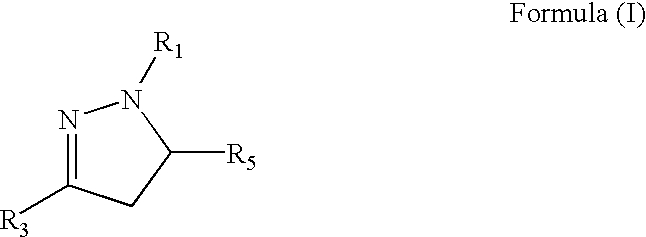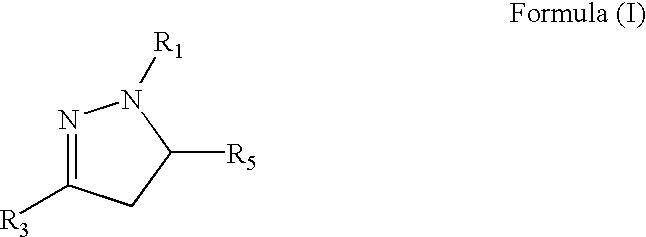Medicinal uses of dihydropyrazoles
a technology of dihydropyrazole and dihydropyrazole, which is applied in the directions of biocide, drug composition, extracellular fluid disorder, etc., can solve the problems of lack of oxygen supply, tissue damage, health problems affecting hundreds of millions of people, etc., and achieves the effects of increasing vascularization of tissue, increasing epo, and safe and effective amoun
- Summary
- Abstract
- Description
- Claims
- Application Information
AI Technical Summary
Benefits of technology
Problems solved by technology
Method used
Image
Examples
example 1
2-(1,5-Diphenyl-4,5-dihydro-1H-pyrazol-3-yl)-pyridine
##STR10##
3-Phenyl-1-pyridin-2-yl-propenone (1c).
Method A: To solution of 2-acetylpyridine 1a (10 mmol, 1 equiv.) and tetrahydrofuran (25 mL) is added benzaldehyde 1b (10 mmol, 1 equiv.). Sodium methoxide (12 mmol, 1.2 equiv.) in methanol (24 mL, 0.5M) is introduced into the reaction and is agitated for 15 hours at room temperature. Hydrochloric acid (1N) is added until a neutral pH is obtained. The solution is extracted with dichloromethane twice, and washed once with water. The combined organic layers are dried over MgSO.sub.4, and concentrated under reduced pressure. The residue is purified by flash column chromatography on SiO.sub.2 (33% ethyl acetate / hexanes) to give the 3-phenyl-1-pyridin-2-yl-propenone 1c as a pale yellow solid. See Hollinshead, S. P., Tetrahedron Letters, Vol 37, pp. 9157-9160 (1996).
Method B: A solution of NaOH (12.8 mmol, 1.28 equiv.) in water (4.55 g) and ethanol (2.32 g) are introduced into a round bott...
example 2
is prepared using 1-acetylbenzene and benzaldehyde (method A) to afford 1,3-diphenyl-propenone. The propenone is reacted with 2-hydrazinopyridine following the procedure described for Example 1.
Example 3
2-(5-Phenyl-1-pyridin-2-yl-4,5-dihydro-1H-pyrazol-3-yl)-phenol
##STR12##
example 3
is prepared using 2-hydroxychalcone and 2-hydrazinopyridine following the procedure described for Example 1.
Example 4
2-(1-Benzothiazol-2-yl-5-phenyl-4,5-dihydro-1H-pyrazol-3-yl)-phenol
##STR13##
PUM
| Property | Measurement | Unit |
|---|---|---|
| temperature | aaaaa | aaaaa |
| temperature | aaaaa | aaaaa |
| temperature | aaaaa | aaaaa |
Abstract
Description
Claims
Application Information
 Login to View More
Login to View More - R&D
- Intellectual Property
- Life Sciences
- Materials
- Tech Scout
- Unparalleled Data Quality
- Higher Quality Content
- 60% Fewer Hallucinations
Browse by: Latest US Patents, China's latest patents, Technical Efficacy Thesaurus, Application Domain, Technology Topic, Popular Technical Reports.
© 2025 PatSnap. All rights reserved.Legal|Privacy policy|Modern Slavery Act Transparency Statement|Sitemap|About US| Contact US: help@patsnap.com



